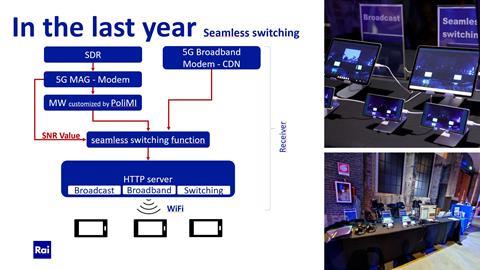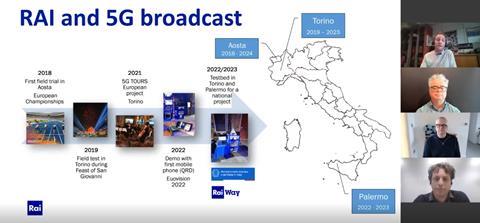IBC365 kicked off a new season of live webinars with a discussion on 5G, the imminent rise of 6G and how leading organisations in broadcast are using pioneering technology and user cases to deliver content to consumers.
The webinar, The maturity of 5G: Is it time to talk about 6G? revealed what the industry has learned so far in implementing 5G networks, what challenges still remain and what is predicted in moving towards a future of 6G.

Robert Ambrose at Caretta Research hosted Morten Brandstrup, Head of News Technology, TV2, Bram Tullemans, Program Manager, European Broadcasting Union and Alessandro Lucco-Castello, Researcher, Radiotelevisione Italiana to discuss 5G technology in today’s news gathering and demonstrated use cases.
The webinar, now available on-demand, explored firsthand the dedicated and secure connections for live streaming, reduced latency, and more efficient network resource utilisation, as well as the current state of 5G deployment.
“What’s interesting right now is this service layer that you’re able to put into 5G.” - Morten Brandstrup, Head of News Technology, TV2
Brandstrup and Tullemans discussed the challenges faced by mobile network operators in offering reliable and high-quality services for content production, while Lucco-Castello emphasised the need for network densification, using coverage in more remote and dense cities across Italy as an example, covering areas with poor mobile network connectivity and reducing CDN costs.
Filling in the gaps of 4G
Morten Brandstrup (TV2) discussed 5G’s impact on live production and news gathering, “For news gathering, what we were missing from 4G was it was just best effort – broadband on a consumer level. What’s interesting right now is this service layer that you’re able to put into 5G,” something TV2 are currently experiencing, “that really seems to be the game changer that we are looking for.”
Read more IBC Accelerators: 5G Mocap for Performance Arts and Live 3D Animation
He went on to summarise that 5G is the “next level” of 4G – “it’s an evolution.”
He later highlighted 5G’s lower latency and higher quality IP control compared to commercial networks.
The speakers addressed the work that still needs to be done with 5G, but is this the responsibility of the broadcasters or the telecom operator companies?
Tullemans, from the EBU, who have produced a report on the state of play of 5G, shared his thoughts - that 5G development still needs time: “For the industry, 4G is still cheap and (delivers) reliable good speeds also. So you’ll see that the telco industry still employs 4G because it has a good return on investments,” he compares this to introducing 5G, “Because of all the R&D pumped into it, it’s still a bit expensive to roll out. So that takes time and what we try to do is to work together with the telco industry to create those use cases.
“We work on the industrialisation and (as soon as) a programme of 5G emerges we’ll be looking at creating lower costs entry solving, taking away bottlenecks in the market. We are developing antennas for cars and we are building specific setups with quick caches… so a lot of those trajectories to get industrialisation started, that’s where we are now. I think it will take a few years to get to the real full deployments.”
Use Case Scenarios
Lucco-Castello introduced a project carried out by RAI, whereby testbeds were used in Italy “to understand the potential for 5G technology. To understand if we can use existing networks to upgrade and to add the 5G broadcast capability using the existing tower and the existing transmitter site, simulating three different scenarios whilst using the same network.”
Through a presentation he shared the results where the team used only one transmitter. The goal was to enable transmitters to have better coverage and tackle the issue of blind spots.
The use case will lead on to future projects in high population density areas, “in 2025 we will start broadcasting in the five big cities in Italy in order to start not just a trial, but a service.”
He shared good results using the same network with different modulation schemes for rooftop reception and pedestrian handheld devices.
Collaborative Power
The three speakers all emphasised that 5G technology and its potential for broadcasting relied upon industry collaboration, which is crucial for 5G adoption and cost reduction.

“The very problem we have now is the terminal that people have to use,” Lucco-Castello stated, “We want to show the potential of the technology, also to involve the market to produce a device on the shelf and not only a prototype.”
Robert Ambrose added: “We’re at the hands of the Apple and Samsung of this world to enable this technology into a smartphone.”
More Challenges on the Horizon
As audience questions started to come in from the live audience, the industry-wide concerns with sustainable practices was pointed out: What are the main differences in power consumption between 4G and 5G and what can be done to reduce this footprint?
“That’s the way things work and how things move forward so it’s logical now that we start on 6G even though we are now in an industrialisation phase of 5G.” - Bram Tullemans, Program Manager, European Broadcasting Union.
Tullemans revealed that those figures, “trustable data on energy consumption” are difficult to get even for fixed networks, “but what I can say is 5G broadcast model is much more efficient, because they are one to many and there is no one-on-one connection needed.”
Brandstrup agreed, adding: “In general (5G networks) consume less power per megabit distributed. And when you look into the private network when we have set (these) up in the studio, it replays five different other radio systems as they enter… so in that sense it’s one to five for the same bandwidth.”
Evolution Beyond 5G
So if 5G is still not perfected as a vehicle for broadcast, is it wise to be thinking about 6G?
Tullemans summarised his thoughts on 6G: “If people start talking about the next phase…pushing things to the next iteration, beyond 5G… (this is just) goal setting (which) needs to be done.” He describes how this means connectivity in dense areas will be difficult – how you reach those areas where IP delivery and traffic are issues, that these are still valid challenges to be solved.
“That’s the way things work and how things move forward so it’s logical now that we start on 6G even though we are now in an industrialisation phase of 5G,”he said.
The speakers went on to speak about business models for rolling out 5G broadcast, and whether we should be getting excited for 6G and what it might offer in the future.
Brandstrup reminded the audience: “5G is the ability to make low latency but high production, for all kinds of events not only broadcast but all media… the ability to make it easy to set up. 6G is not just about more bandwidth, it’s the latency issue which really hasn’t been solved so far with 5G.”
He predicted that cloud for live production, camera to cloud workflows, and remote production will be the next big thing.
Tullemans added: “Production is great example but also in the distribution area we are looking at - VPN, back-ends, distribution to contain other content,” he then declared it is the deployment models and use cases that “we are waiting for now.”
Lucco-Castello’s main concern for a future of solid 5G deployment and moving into 6G, is trying to understand the distribution part of the puzzle: “Our commitment is that 5G broadcast has to be stable for some years to start to enable people to change their device. In the future we expect 6G synergy. The future is maybe the synergy.”
Tullemans concluded: “Things need to be deployed now. Everything still needs to happen.”
Register now for the next webinar on 24 April The Collision of Gaming and TV
























No comments yet